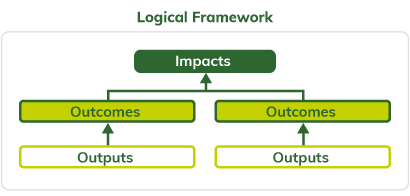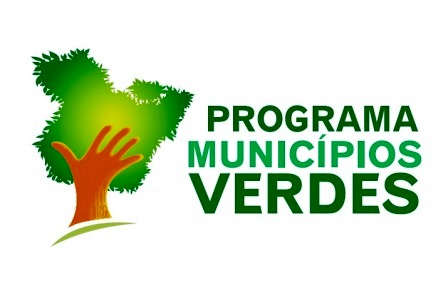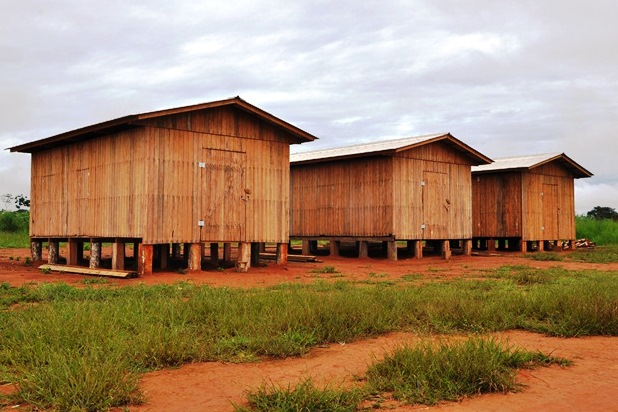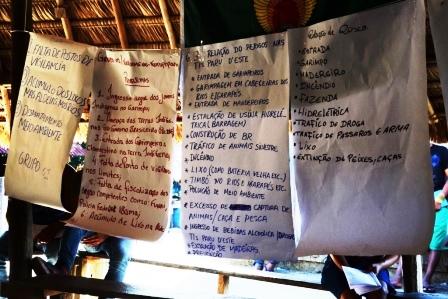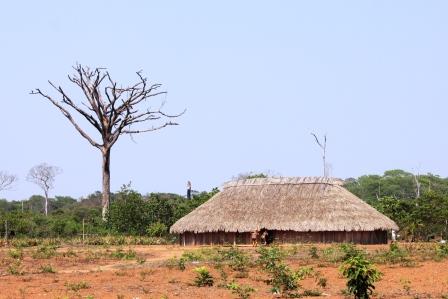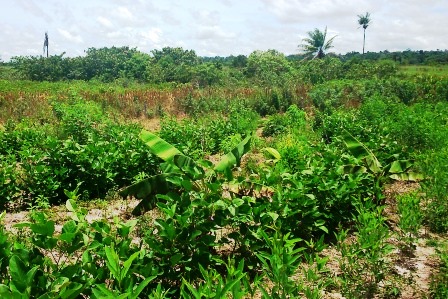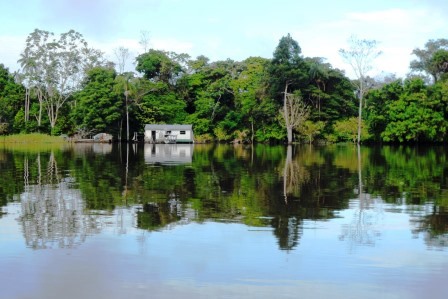RESULT AND IMPACT INDICATORS
The activities of the project contributed to the results related to the components “sustainable production” (1) and “science, innovation and economic instruments” (4) of the Amazon Fund’s Logical Framework.
Direct effect 1.3: Expansion of administrative and technical capabilities for the implementation of SAFs, cooperatives and management of associations
The main indicators used to monitor this objective were:
- Number of individuals trained in the implementation of SAFs, at the technical or administrative level (output indicator)
Goal: 500 | Result achieved: 540
- Number of individuals trained in the implementation of SAFs, at the technical or administrative level, who effectively used the knowledge acquired (outcome indicator)
Goal: 300 | Result achieved: 353
- Number of families (rural properties) who benefited from technical assistance (output indicator)
Goal: 500 | Result achieved: 1,201
- Number of individuals trained in the management of associations and implementation of cooperatives as a means of accessing the market, at the technical or administrative level (output indicator)
Goal: 100 | Result achieved: 114
Direct effect 1.4: Recovery of deforested and degraded areas so they can be used for production through SAFs
The main indicators used to monitor this objective were:
- Number of awareness-raising or integration events focused on environmental regularization and recovery of deforested or degraded areas (output indicator)
Goal: 15 | Result achieved: 42
- Number of community organizations strengthened (associations and cooperatives) (outcome indicator)
Goal: 10 | Result achieved: 14
- Area recovered and used for economic purposes (outcome indicator)
Goal: 500 hectares | Result achieved: 742 hectares
- Number of properties with sustainable production projects – implementation of SAFs (output indicator)
Goal: 500 hectares | Result achieved: 505 hectares
- Revenue from sustainable economic activities (outcome indicator)
Goal: undefined | Result achieved: R$ 724,000
- Number of seedlings produced by the nursery in Itapuã do Oeste with support from the project (output indicator)
Goal: 800,000 | Result achieved: 1,035,000
- Total amount paid for environmental services (output indicator)
Goal: R$ 292,000 | Result achieved: R$ 415,000
- Number of families who received payment for environmental services (output indicator)
Goal: undefined | Result achieved: 471 families
- Area that benefited from the payment for environmental services (outcome indicator)
Goal: undefined | Result achieved: 257 hectares
Direct effect 4.1: Dissemination of knowledge and technologies for sustainable use in Rondônia
The main indicators used to monitor this objective were:
- Number of researchers and technicians involved in CT&I activities residing in the Amazon during the execution of the project (outcome indicator)
Goal: 10 | Result achieved: 13
- Number of scientific publications produced (outcome indicator)
Goal: undefined | Result achieved: 1
Finally, the behavior of the deforestation rate in the municipalities of the state of Rondônia that benefited from the project’s actions was monitored, despite the impact of these actions being limited, considering their scale in view of the various vectors that contribute to deforestation in this region.
- Annual deforestation in the municipalities of Machadinho d’Oeste, Cujubim and Itapuã do Oeste in the state of Rondônia (outcome indicator)
Goal: undefined | Result achieved: 164 km2 (2018)
The annual deforestation due to clearcutting observed in 2018 in the municipalities of the state of Rondônia that benefited from the project’s actions was 164 km2. Considering that in 2013, this rate had been 153 km2 (baseline), there was an increase of approximately 7% in the annual deforestation rate from 2013 to 2018.
|
Annual deforestation (km2)
|
|
|
Municipality
|
Baseline
(2013)
|
2014
|
2015
|
2016
|
2017
|
2018
|
Variation %
2018/2013
|
|
| |
|
Machadinho d’Oeste
|
81.2
|
61.4
|
98.3
|
93.7
|
99.4
|
74.1
|
-9
|
|
|
Cujubim
|
55.3
|
40.6
|
65.8
|
85.9
|
87.1
|
73.2
|
32
|
|
|
Itapuã do Oeste
|
16.9
|
9.0
|
8.9
|
16.4
|
14.2
|
17.1
|
1
|
|
|
Total
|
153
|
111
|
173
|
196
|
201
|
164
|
7
|
|
Source: Prepared by the authors based on data from Inpe/Prodes.
Institutional and administrative aspects
The project established partnerships with several institutions, with the support of the municipal government of Itapuã do Oeste (production of seedlings in the municipal nursery), the National Institute of Colonization and Agrarian Reform – Incra (authorization to implement SAFs in the settlements), and the Federal University of Rondônia (soil and landscape studies), having also collaborated with the Executive Committee of the Cocoa Farming Plan (Ceplac)². This public agency provided cocoa seeds and technical knowledge and assisted in the preparation and implementation of the SAFs.
The independent annual audits improved aspects of Rioterra’s management, adapting its processes to the best market practices, including the creation of a Code of Ethics and its Internal Regulation.
² Ceplac is an agency of the Ministry of Agriculture, Livestock and Supply.
Risks and lessons learned
It can be said that the project has developed favorably. In terms of results, all the products and services planned were implemented, and all their objectives were achieved.
The mobilization activities carried out with the community associations are noteworthy, having contributed to the success of the project. Rioterra adopted the practice of visiting the headquarters of these associations, allowing broad participation and involvement of the beneficiaries and strengthening the bonds of acceptance and credibility between the parties.
The project innovated by introducing payment for environmental services in order to recognize the implementation and good maintenance practices carried out by the beneficiaries in the areas recovered by the project, based on the following technical criteria: (i) complete implementation of the SAF; (ii) application of the inputs offered to implement the SAF (limestone, fertilizer, etc.); (iii) performance of maintenance to ensure the regeneration of the SAF’s area; (iv) presence of a fence to isolate the area being recovered and (iii) good condition of the ground cover.
Sustainability of the results
The project contributed to the environmental regularization of the rural properties of small family farmers, generating income through the recovery of deforested areas using SAFs. These results tend to be sustained over time, as SAFs consolidate themselves as an income option for these populations and the Brazilian environmental legislation is implemented by society.
The results achieved by the various training programs carried out by the project have expanded the knowledge of the benefited public on the implementation of SAFs, agroecology, associations, and other technical topics. These programs tend to have lasting and extended effects, if we consider the diffusion of knowledge that naturally occurs in interpersonal relationships.
In turn, the laboratory for soil analysis at the Federal University of Rondônia, modernized and structured by the project, is part of the structure of UNIP, there being no reason to expect its paralysis or discontinuity.
It is worth mentioning that the Amazon Fund supports a new project presented by Rioterra, namely, the Plantar Rondônia project. This new project covers 12 municipalities, including the three municipalities benefited by the Amazon Backyards project, and its main objective is to contribute to the advancement of the environmental adequacy of small rural properties in the state of Rondônia.
It is believed that this new project, by significantly expanding the area and the number of properties to be environmentally restored and providing technical assistance and rural extension (Ater) to ensure the sustainability and technical excellence of agriculture, will also contribute to the durability of good results already achieved by the Amazon Backyards project.


